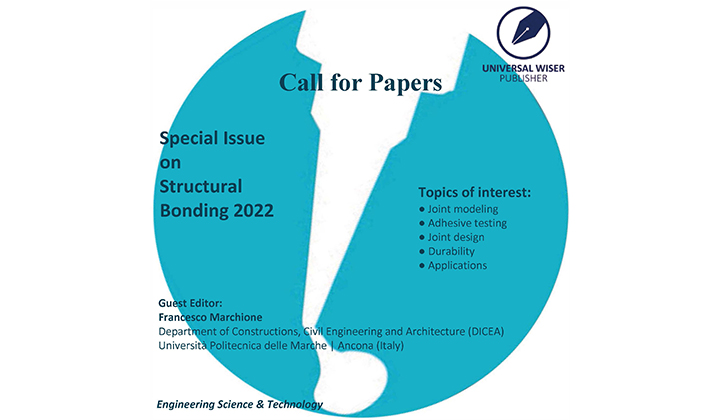


Engineering Science & Technology-Special Issue on Structural Bonding
It’s our great honor and privilege to invite you to submit your papers to our special issue structural bonding!
The use of structural adhesives is increasing considerably in various sectors due to the many benefits they offer. Compared to traditional joining technologies, adhesive joints improve stress distribution and allow dissimilar materials to be joined together. The result is to assemble ductile joints, obtained by combining materials with different mechanical characteristics. However, due to the polymeric and non-linear nature of the adhesive material, its behavior is still under study. Indeed, some aspects related to the rheology of the material and its behavior after severe environmental exposure make the design of the joint difficult.
This special issue will focus on the design aspects of the adhesive joint according to the different applications (e.g. automotive, marine, civil engineering, dental, etc.). In particular, the theoretical (i.e., stress analysis, strength analysis) and experimental aspects as well as numerical (FE and combined analytical) analyses of the mechanical behavior of the joint are discussed.
Topics of interest for this special issue include, but are not limited to:
● Joint modeling
This deals with the numerical and analytical modeling of adhesive joints in relation to recent research developments. Since adhesives are strongly non-linear materials, their mathematical and numerical modeling is still essential for predicting their mechanical behavior.
● Adhesive testing
It involves the experimental analysis of adhesive joints in relation to different combinations of loads, adherents, and adhesives under different environmental exposures.
● Joint design
This incorporates the results of the previous two and proposes design methodologies for designers. By comparing the experimental results, the numerical model is evaluated and one or more design methodologies are defined in relation to the service life of the adhesive joint.
● Durability
The rheological behavior of adhesives in relation to prolonged exposure to adverse environmental conditions (e.g. temperature and relative humidity, saline environments, etc) is worthy studying. Environmental exposure strongly influences the polymeric nature of adhesives. This is reflected in the actual behavior of the adhesive joints under operating conditions.
● Applications
Here the real, industrial, or patent applications of adhesive joints (e.g. automotive, civil engineering, etc.) should be illustrated. This brings together the previous ones and illustrates the potential of the adhesive systems in everyday life.
Guest Editor:
Francesco Marchione
Department of Constructions, Civil Engineering and Architecture (DICEA)
Università Politecnica delle Marche | Ancona (Italy)
Submission instructions:
● Send directly to mailbox: editorial-est@wiserpub.com;
Submit online via the OJS: https://ojs.wiserpub.com/index.php/EST/login
● Author guidelines: https://ojs.wiserpub.com/index.php/EST/about/submissions
Before preparing the manuscript, it’s recommended to read the Guidelines carefully.
● Deadline for manuscript submission: October 31, 2022
● Publication fee: free of APC or any other publication fees
● Note: All submissions will go through the regular double-blind peer review process and follow standard norms.
If you have an interest in this Issue and would like to know more about it, please feel free to contact us!

Scheduled Server Maintenance and System Downtime Notice Dec 16, 2025

Celebrating CM Editorial Board Members Recognized in the Wor... Oct 10, 2025

Food Science and Engineering Now Indexed in CAS Database Aug 20, 2025

Contemporary Mathematics Achieves Significant Milestone in 2... Jun 19, 2025

Three Journals under Universal Wiser Publisher are Newly Ind... Apr 21, 2025